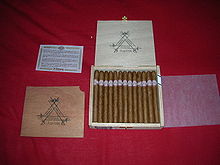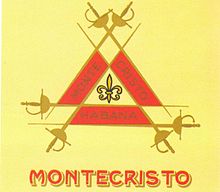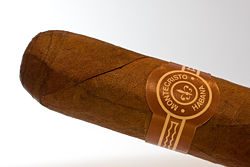- Montecristo (cigar)
-
Montecristo is the name of two brands of premium cigars, one produced in Cuba for Habanos SA, the Cuban state-owned tobacco company, and the other produced in La Romana, Dominican Republic for the Franco-Spanish tobacco monopoly Altadis SA.
Contents
History
In July 1935, Alonso Menéndez purchased the Particulares Factory, makers of the popular Particulares brand and the lesser-known Byron. Immediately after its acquisition, he created a new brand named Montecristo.[1]
The name for the brand was inspired by the Alexandre Dumas, père novel The Count of Monte Cristo, which was supposedly a very popular choice among the torcedores (cigar rollers) in their factory to have read by the lector on the rolling floor. The now-famous Montecristo logo, consisting of a triangle of six swords surrounding a fleur-de-lis, was designed by John Hunter Morris and Elkan Co. Ltd., the brand's British distributor.
In July 1936, Menéndez founded a new firm with a partner, naming it Menéndez, García y Cía.[2] With the growing success of the Montecristo brand, the firm purchased the faltering H. Upmann Factory from J. Frankau SA in 1937 and transferred the production of Montecristo from the Particulares Factory to H. Upmann, which continued to be the home of the Montecristo brand after the Revolution.
J. Frankau continued to be the sole distributor of the H. Upmann brand in the UK, while John Hunter Morris and Elkan Co. Ltd. was the sole distributor of Montecristo in Britain. In 1963, these firms would merge to become Hunters & Frankau, which today is the sole importer and distributor of all Cuban cigars in the UK.
Several books have incorrectly stated that the original name of the cigar brand was H. Upmann Montecristo Selection, but the fact that the brand was founded by Menéndez in 1935 and his firm did not acquire H. Upmann until 1937 bears this out.
Through the efforts of Alfred Dunhill (the company), the Montecristo brand became incredibly popular worldwide and to this day accounts for roughly one-quarter of Habanos SA's worldwide cigar sales, making it the most popular Cuban cigar in the world. After the Cuban Revolution and the nationalization of the cigar industry in Cuba in 1961, Menéndez and García fled to the Canary Islands where they re-established the brand, but were later forced to quit due to copyright disputes with Cubatabaco. In the mid-1970s, the operation was moved to La Romana in the Dominican Republic and released for the US market, where Cuba's rights to the brand weren't recognized due to the embargo. Menéndez, García, y Cía is now owned by Altadis SA, who controls its distribution and marketing in the United States.
The original line had only five numbered sizes, with a tubed cigar added during the 1940s, but otherwise remained unchanged until after nationalization. With Menendez and Garcia gone after 1959, one of the top grade torcedores, José Manuel Gonzalez, was promoted to floor manager and proceeded to breathe new life into the brand. In the 1970s and 1980s, five new sizes were added: the A, the Especial No. 1 and 2, the Joyita, and the Petit Tubo. Three other sizes, the Montecristo No. 6, No. 7, and B, were released but subsequently discontinued, though the B can occasionally be found in very small releases each year in Cuba.
Through the 1970s and 1980s, Montecristo continued to rise in popularity among cigar smokers and firmly entrenched itself as one of Cuba's top selling cigar lines. The Montecristo No. 4 is, itself, the most popular cigar in the world market.
In 2004, another new edition to the regular line was made with the Edmundo, a large robusto-sized cigar, named for the hero of Dumas' The Count of Monte Cristo, Edmond Dantès.
Montecristo is also regularly chosen to be featured in Habanos SA's annual Edición Limitada selection of cigars with a darker vintage wrapper and there are numerous limited edition releases of special Montecristo cigars for special occasions, anniversaries, the annual Habanos Festival, charities, etc.
In 2007, a cigar called the Edmundo Dantes Conde 109 was released as a part of Habanos' regional edition series. It uses a Montecristo blend and is believed to have a different name because of trademark right problems in Mexico.
A new, lighter-bodied line was released at the 11th Habanos Festival in February 2009. The planned name for the new line had been Sport, but because of EU regulations prohibiting marketing tobacco with sports imagery, the name was changed to Open with vitola names inspired by sports such as golf and yachting.
Montecristo also produces three machine-made cigarillos: the Mini, the Club, and the Purito.
It is often said by expert aficionados that Montecristo No. 4 is the ideal beginner cigar for those who are new to cigar smoking, and that No. 4 is the gold standard cigar as a bench mark to all other cigars to be compared to.
Vitolas in the Montecristo line
 A box of Cuban Montecristo Joyitas
A box of Cuban Montecristo Joyitas
The following list of vitolas de salida (commercial vitolas) within the Montecristo marque lists their size and ring gauge in Imperial (and Metric), their vitolas de galera (factory vitolas), and their common name in American cigar slang.
Hand-Made Vitolas
- A - 9 1/4" x 47 (235 x 18.65 mm), Gran Corona, a grand corona
- Edmundo - 5 3/8" x 52 (137 x 20.64 mm), Edmundo, a robusto
- Joyita - 4 1/2" x 26 (114 x 10.32 mm), Laguito No. 3, a small panetela
- Especial No. 1 - 7 1/2" x 38 (191 x 15.08 mm), Laguito No. 1, a long panetela
- Especial No. 2 - 6" x 38 (152 x 15.08 mm), Laguito No. 2, a panetela
- No. 1 - 6 1/2" x 42 (165 x 16.67 mm), Cervantes, a lonsdale
- No. 2 - 6 1/8" x 52 (156 x 20.64 mm), Pirámide, a pyramid
- No. 3 - 5 5/8" x 42 (143 x 16.67 mm), Corona, a corona
- No. 4 - 5 1/8" x 42 (130 x 16.67 mm), Mareva, a petit corona
- No. 5 - 4" x 40 (102 x 15.88 mm), Perla, a petit corona
- Tubo - 6 1/8" x 42 (156 x 16.67 mm), Corona Grande, a long corona
- Petit Edmundo - 4 3/8" x 52 (111 x 20.64 mm), Petit Edmundo, a petit robusto
- Petit Tubo - 5 1/8" x 42 (130 x 16.67 mm), Mareva, a petit corona
The Open Series
- Eagle - 5 7/8" x 54 (149 x 21.43 mm), Geniales, a robusto extra
- Junior - 4 3/8" x 38 (111 x 15.08 mm), Trabuco, a short panetela
- Master - 4 7/8" x 50 (124 x 19.84 mm), Robusto, a robusto
- Regata - 5 1/3" x 46 (135 x 18.26 mm), Forum, a pyramid
Edición Limitada Releases
- Double Corona (2001) - 7 5/8" x 49 (194 x 19.45 mm), Prominente, a double corona
- Robusto (2001) - 4 7/8" x 50 (124 x 19.84 mm), Robusto, a robusto
- C (2003) - 5 5/8" x 46 (143 x 18.26 mm), Corona Gorda, a grand corona
- D (2005) - 6 3/4" x 43 (171 x 17.07 mm), Dalia, a lonsdale
- Robusto (2006) - 4 7/8" x 50 (124 x 19.84 mm), Robusto, a robusto
- Sublime (2008) - 6 1/2" x 54 (165 x 21.43 mm), Sublime, a double robusto
Edición Regional Releases
- Edmundo Dantes El Conde (2007) - 7 1/4" x 50 (184 x 19.84 mm), No. 109, a double robusto
Special Releases
- Millennium Reserve Robusto - 4 7/8" x 50 (124 x 19.84 mm), Robusto, a robusto
- B - 5 3/8" x 42 (137 x 16.67 mm), Cosaco, a corona
See also
- Cigar brands
References
- Nee, Min Ron - An Illustrated Encyclopaedia of Post-Revolution Havana Cigars (2003, Reprinted: 2005), ISBN 3-9809308-2-3
External links
- Official website of Habanos S.A.
- The Color and Complexity of Cuba's Cigars CNN, April 9, 2007
Imperial Tobacco Brands Backwoods · Bali Shag · Cabinet · Classic · Davidoff · Drum · Ducados Rubio · Dutch Masters · Dux · Embassy · Ernte 23 · Excellence · Farías · Fine · Fortuna · Gauloises · Gitanes · Golden Virginia · H. Upmann · Henry Clay · Horizon · JPS · Lambert & Butler · Malibu · Marquise · Maxim · McClintock · Mocne · Montclair · Montecristo · Mustang · News · Nobel · Phillies · Por Larrañaga · Premier · Quintero · R1 · Regal · Richmond · Rizla · Romeo y Julieta · Route 66 · Sonoma · Superkings · Trinidad · USA Gold · Van Nelle · Vegafina · West · Windsor BlueSubsidiaries Predecessors Edwards Ringer · F & J Smith · Franklyn Davey · J & F Bell · Lambert & Butler · Stephen Mitchell & Son · W.D. & H.O. Wills · William Clarke & Son
Categories:- Habanos S.A. brands
Wikimedia Foundation. 2010.


